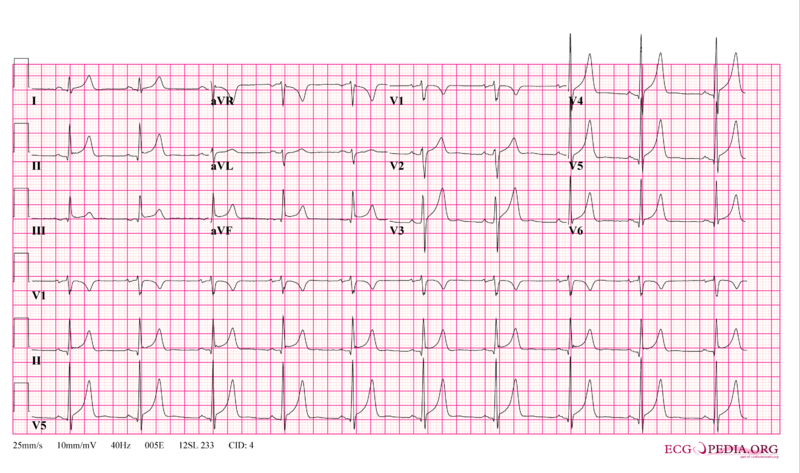Radiation induced pericarditis
|
Pericarditis Microchapters |
|
Diagnosis |
|---|
|
Treatment |
|
Surgery |
|
Case Studies |
|
Radiation induced pericarditis On the Web |
|
American Roentgen Ray Society Images of Radiation induced pericarditis |
|
Risk calculators and risk factors for Radiation induced pericarditis |
Editor-In-Chief: C. Michael Gibson, M.S., M.D. [1]; Associate Editor(s)-In-Chief: Varun Kumar, M.B.B.S.; Lakshmi Gopalakrishnan, M.B.B.S.
Overview
The survival rate in Hodgkin lymphoma, Non-Hodgkin's lymphoma and breast carcinomas has significantly improved with use of radiation therapy. However, radiation therapy to thoracic and mediastinal cancers have also led to development of pericarditis, coronary artery disease, cardiomyopathy, conduction abnormalities in heart and valvular heart diseases which account for significant morbidity and mortality. The incidence is higher with doses greater than 40 Gy (4000 rad).
Pathophysiology
Radiation exposure causes endothelial damage, capillary rupture, and platelet adhesion which initiates an inflammatory response and leads to development of adhesions between the two membranes of pericardium. Collagen and fibrous deposition occur on the outer layer of the heart leading to pericardial fibrosis, effusion, and sometimes tamponade [1]
Radiation induced pericarditis depends on:
- Total dose of radiation
- Amount of cardiac silhouette exposed
- Nature of the radiation source
- Duration and fractionation of therapy
In a retrospective study, 27.7% of the patients developed pericardial effusion after median time period of 5.3 months following radiotherapy for esophageal carcinoma with radiation dose ranging between 3 to 50Gy. It was concluded that high dose-volume of the irradiated pericardium and heart increased the risk of developing pericarditis[2].
Epidemiology and Demographics
Incidence of radiation induced pericarditis has significantly decreased with the use of lower doses and newer radiotherapy techniques[3][4]. In a study, incidence decreased from 20% to 2.5% with the changes in methods of RT administration[5]
In as study among pediatric population with various cancers, radiation therapy with ≥15 GY increased the risk of developing pericarditis by two to six times[6]
Diagnosis
History and Symptoms
Radiation induced pericarditis may present in two forms:
- Acute pericarditis
- Late onset pericarditis occur from about a year to up to 20 years after exposure
Patients may present with the following symptoms:
- Fever
- Chest pain that improves on leaning forward and worsens on inspiration
- Breathlessness
- Dizziness
- Palpitation
- Malaise
- Ankle edema
Physical Examination
Patients may present with fever
Vitals
Pulse
Rate
Blood Pressure
Neck
- Jugular venous distension with a prominent Y descent and Kussmaul's sign
Heart
- Ewart's sign may be present. This includes a pericardial knock
- Pericardial rub(heard best while leaning forwards) and distant heart sounds
Abdomen
Extremities
Electrocardiogram
Non-specific ST and T wave changes or ST segment elevation in all leads may be noted.

Pericardiocentesis
Radiation induced pericardial effusion can be confused with malignant pericarditis and hypothyroidism (secondary to mediastinal irradiation) induced pericarditis. Pericardiocentesis can be used to differentiate them with fluid analysis for malignant cells and thyroid function tests.
Treatment
- Pericarditis with large effusion can be drained either percutaneously or surgically
- Those with recurrent pericardial effusion can be treated with pericardiotomy(pericardial window) or by surgical stripping.
- Pericardiectomy is recommended for patients who develop constrictive pericarditis. However, the perioperative mortality rate is higher in postradiation constrictive pericarditis compared to that of idiopathic constrictive pericarditis[7].
References
- ↑ Hooning MJ, Aleman BM, van Rosmalen AJ, Kuenen MA, Klijn JG, van Leeuwen FE (2006). "Cause-specific mortality in long-term survivors of breast cancer: A 25-year follow-up study". Int J Radiat Oncol Biol Phys. 64 (4): 1081–91. doi:10.1016/j.ijrobp.2005.10.022. PMID 16446057.
- ↑ Wei X, Liu HH, Tucker SL, Wang S, Mohan R, Cox JD; et al. (2008). "Risk factors for pericardial effusion in inoperable esophageal cancer patients treated with definitive chemoradiation therapy". Int J Radiat Oncol Biol Phys. 70 (3): 707–14. doi:10.1016/j.ijrobp.2007.10.056. PMID 18191334.
- ↑ Maisch B, Ristić AD (2003). "Practical aspects of the management of pericardial disease". Heart. 89 (9): 1096–103. PMC 1767862. PMID 12923044.
- ↑ Maisch B, Seferović PM, Ristić AD, Erbel R, Rienmüller R, Adler Y; et al. (2004). "Guidelines on the diagnosis and management of pericardial diseases executive summary; The Task force on the diagnosis and management of pericardial diseases of the European society of cardiology". Eur Heart J. 25 (7): 587–610. doi:10.1016/j.ehj.2004.02.002. PMID 15120056.
- ↑ Carmel RJ, Kaplan HS (1976). "Mantle irradiation in Hodgkin's disease. An analysis of technique, tumor eradication, and complications". Cancer. 37 (6): 2813–25. PMID 949701.
- ↑ Mulrooney DA, Yeazel MW, Kawashima T, Mertens AC, Mitby P, Stovall M; et al. (2009). "Cardiac outcomes in a cohort of adult survivors of childhood and adolescent cancer: retrospective analysis of the Childhood Cancer Survivor Study cohort". BMJ. 339: b4606. doi:10.1136/bmj.b4606. PMID 19996459.
- ↑ Bertog SC, Thambidorai SK, Parakh K, Schoenhagen P, Ozduran V, Houghtaling PL; et al. (2004). "Constrictive pericarditis: etiology and cause-specific survival after pericardiectomy". J Am Coll Cardiol. 43 (8): 1445–52. doi:10.1016/j.jacc.2003.11.048. PMID 15093882.